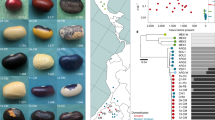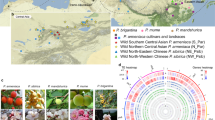Abstract
Early domestication and extensive cultivation1 have meant that staple Mediterranean fruit crops such as olives, grapes and dates exist in wild-looking forms that are secondary derivatives produced by sexual reproduction among cultivated plants (cultivars), which were initially propagated vegetatively2. By using genetic markers associated with characters that render plants unsuitable for domestication, we show here that genuinely wild olive trees, which cannot be distinguished morphologically from feral forms, still survive in a few Mediterranean forests. These wild stocks are genetically distinct and more variable than either the crop strains or their derived feral forms, a finding that has important implications for the conservation of these ancient lineages.
Similar content being viewed by others
Main
We surveyed ten forests in seven countries around the Mediterranean basin (Fig. 1) to identify any surviving genuinely wild olive trees. These forests were selected as the most likely to contain these rare trees, according to whether they were exposed to past and present climatic conditions suitable for oleaster growth3, and from consideration of their past and present isolation from areas of cultivated olive trees. We also assessed whether the large oleaster populations (wild and feral forms are collectively known as oleasters) in these forests might have offset the influence of occasional pollen and seed flow from cultivated areas. In the eastern part of the basin, where olive trees have been extensively cultivated for longer periods1, we used less restrictive criteria, but still found no candidate forests in Egypt, Syria, Turkey, Crete or Greece.
Five different alleles (each represented by a different symbol) peculiar to these trees were found to be present at frequencies of 4–32%, 8–14%, 20–24%, 10–22% and 4–15%, respectively; these were present exclusively in the 10 forests suspected of containing genuinely wild olives. Arrows, population locations tested. For each country, the sequence of four numbers indicates populations of wild oleasters, feral oleasters, formal cultivars and locally cultivated clones, respectively, that were scored genetically.
In each selected forest, we sampled 40 trees and scored them for allozyme markers, particularly at loci that are known to be genetically linked to regions that control the juvenile phase4 which, if prolonged, is unsuitable for olive domestication. We compared our results to those obtained at the same loci from 802 olive clones representing the main domesticated olive5,6,7 and from 1,395 feral olives from 62 sites4,8, including forests throughout the Mediterranean basin that did not satisfy our selection criteria.
Of the 26 alleles identified at eight loci, two alleles at each of the two loci associated with characters unsuitable for domestication, as well as another allele at another locus, were present exclusively in the populations of the 10 selected forests considered most likely to contain genuinely wild olives (Fig. 1). The other alleles were common to cultivated olives and oleasters, whatever their origins. In the occidental area, the average genetic differentiation values (Fst) are 6% between the eight putative wild populations and 22% between these and other nearby oleaster populations.
Our results provide evidence of the survival of indigenous oleaster populations, particularly in the western part of the basin, as suggested previously1. Genetic-diversity values over cultivars, feral olives and the wild olives of the selected forests were 0.286, 0.414 and 0.506, which is consistent with our interpretation that the domesticated olive represents a sample of the genetic variation in genuinely wild olive populations that persist today. Owing to their very long lifespan, these wild trees should be closely related to the neolithic olives recognized as the crop progenitor. Our discovery will encourage the preservation of environmental conditions that favour the survival of large populations of oleasters that are properly isolated from cultivated olive trees.
References
Zohary, D. & Spiegel-Roy, P. Science 187, 319–327 (1975).
Turrill, W. B. Kew Bull. 3, 439–442 (1951).
Terral, J. F. & Mengüal, X. Palaeogeogr. Palaeoclim. Palaeoecol. 153, 71–92 (1999).
Ouazzani, N., Lumaret, R., Villemur, P. & Di Giusto, F. J. Hered. 84, 34–42 (1993).
Ouazzani, N., Lumaret, R. & Villemur, P. Agronomie 15, 31–37 (1995).
Trujillo, I., Rallo, L. & Arùs, P. J. Am. Soc. Hort. Sci. 120, 318–324 (1995).
Ouazzani, N., Lumaret, R. & Villemur, P. Euphytica 91, 9–20 (1996).
Lumaret, R., Ouazzani, N., Michaud, H. & Villemur, P. Bocconea 7, 39–42 (1997).
Author information
Authors and Affiliations
Corresponding author
Rights and permissions
About this article
Cite this article
Lumaret, R., Ouazzani, N. Ancient wild olives in Mediterranean forests. Nature 413, 700 (2001). https://doi.org/10.1038/35099680
Issue Date:
DOI: https://doi.org/10.1038/35099680
This article is cited by
-
Genome-wide identification and characterization of a plant-specific Dof transcription factor gene family in olive (Olea europaea) and its comparison with Arabidopsis
Horticulture, Environment, and Biotechnology (2021)
-
Genomic evidence for recurrent genetic admixture during the domestication of Mediterranean olive trees (Olea europaea L.)
BMC Biology (2020)
-
Plant remains from Roman period town of Obulco (today Porcuna) in Andalusia (Spain)—distribution and domestication of olive in the west Mediterranean region
Archaeological and Anthropological Sciences (2018)
-
Genetic structure of cultivated Zanthoxylum species investigated with SSR markers
Tree Genetics & Genomes (2018)
-
Molecular and phytochemical analysis of wild type and olive cultivars grown under Saudi Arabian environment
3 Biotech (2017)
Comments
By submitting a comment you agree to abide by our Terms and Community Guidelines. If you find something abusive or that does not comply with our terms or guidelines please flag it as inappropriate.




